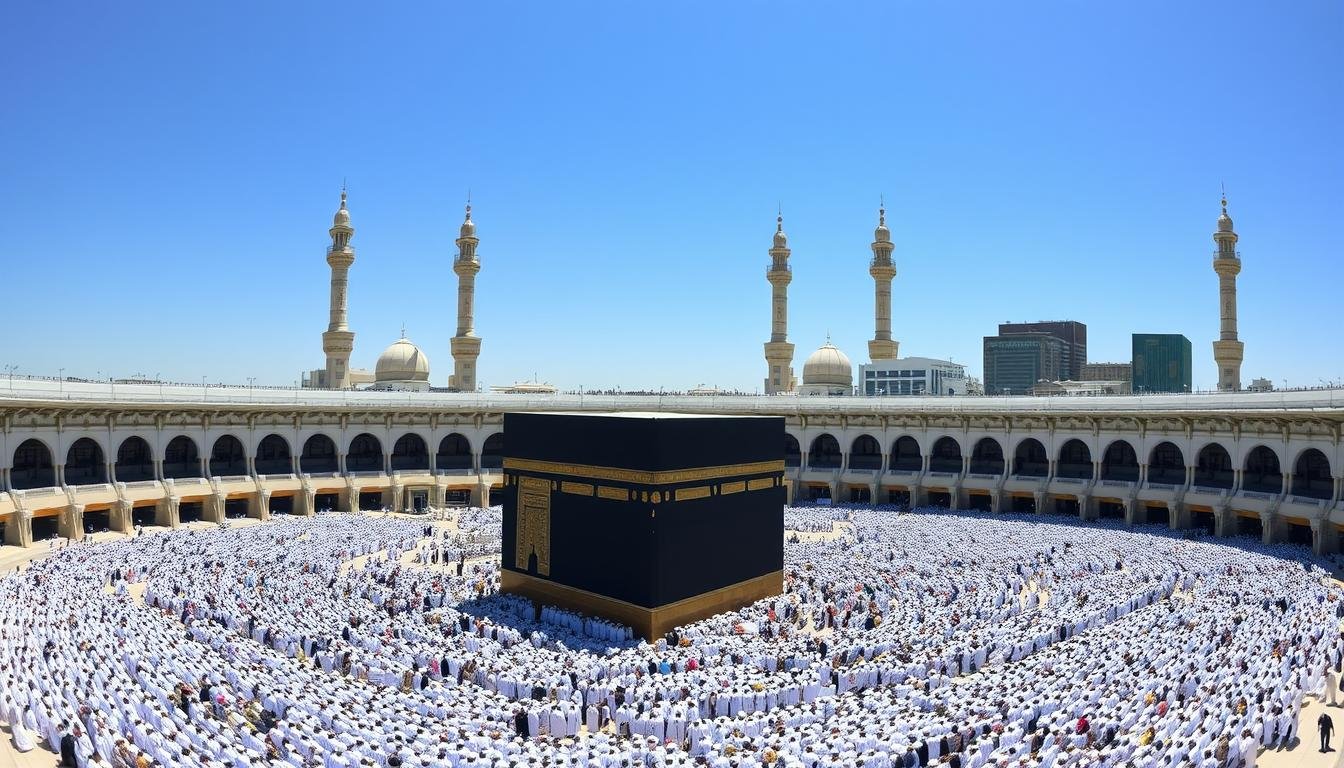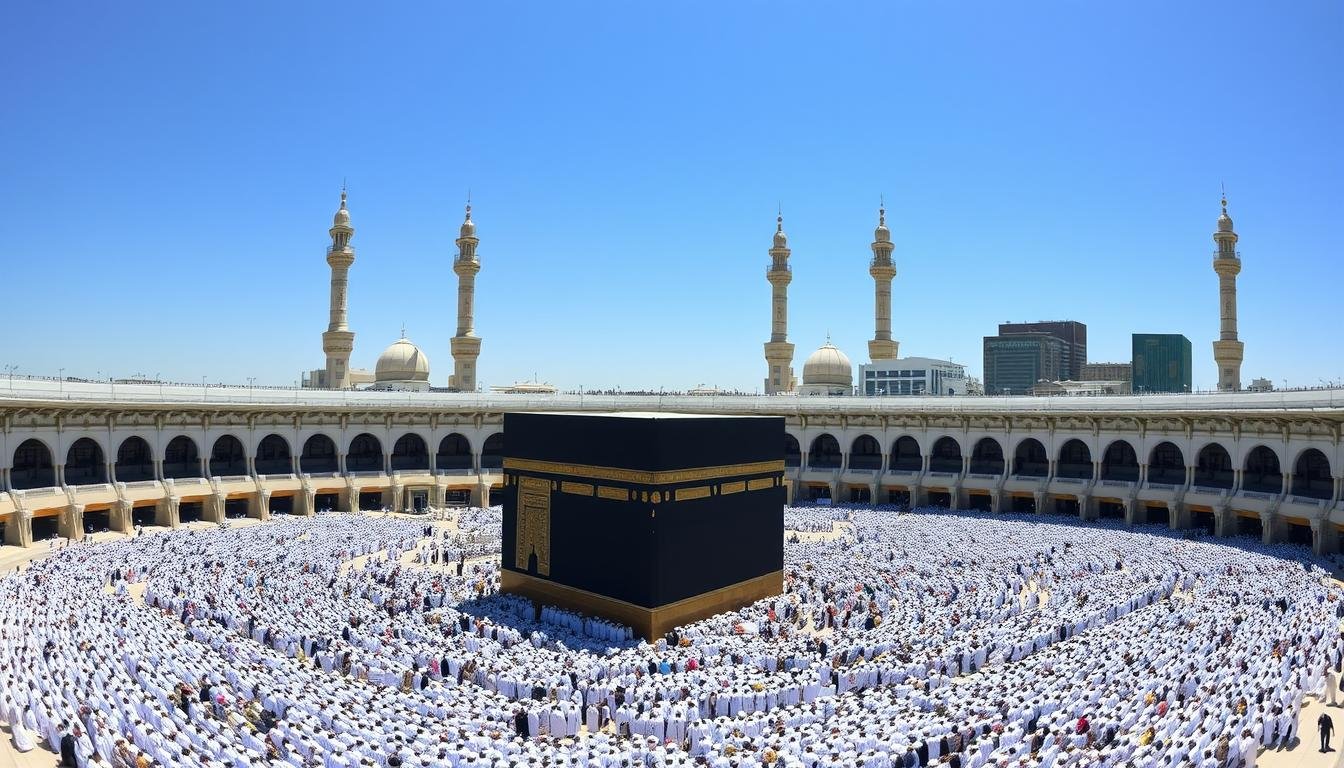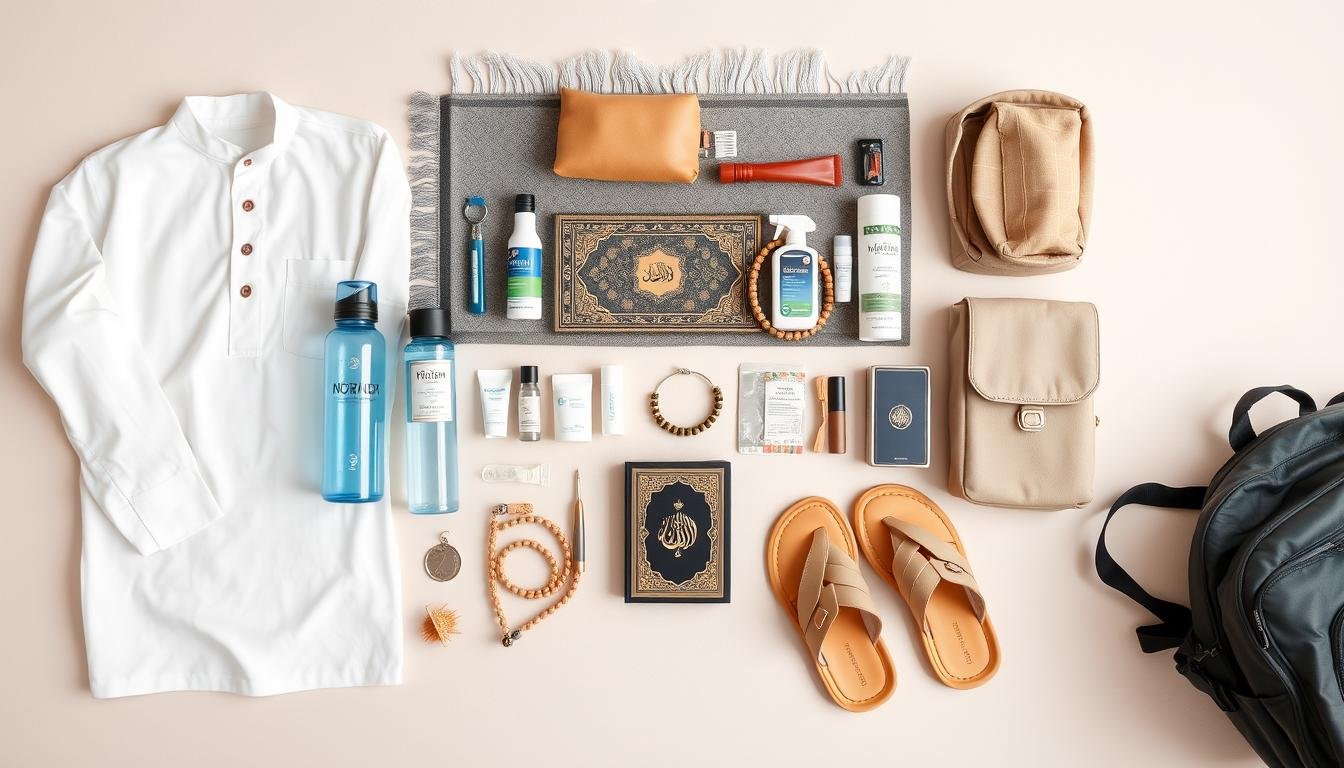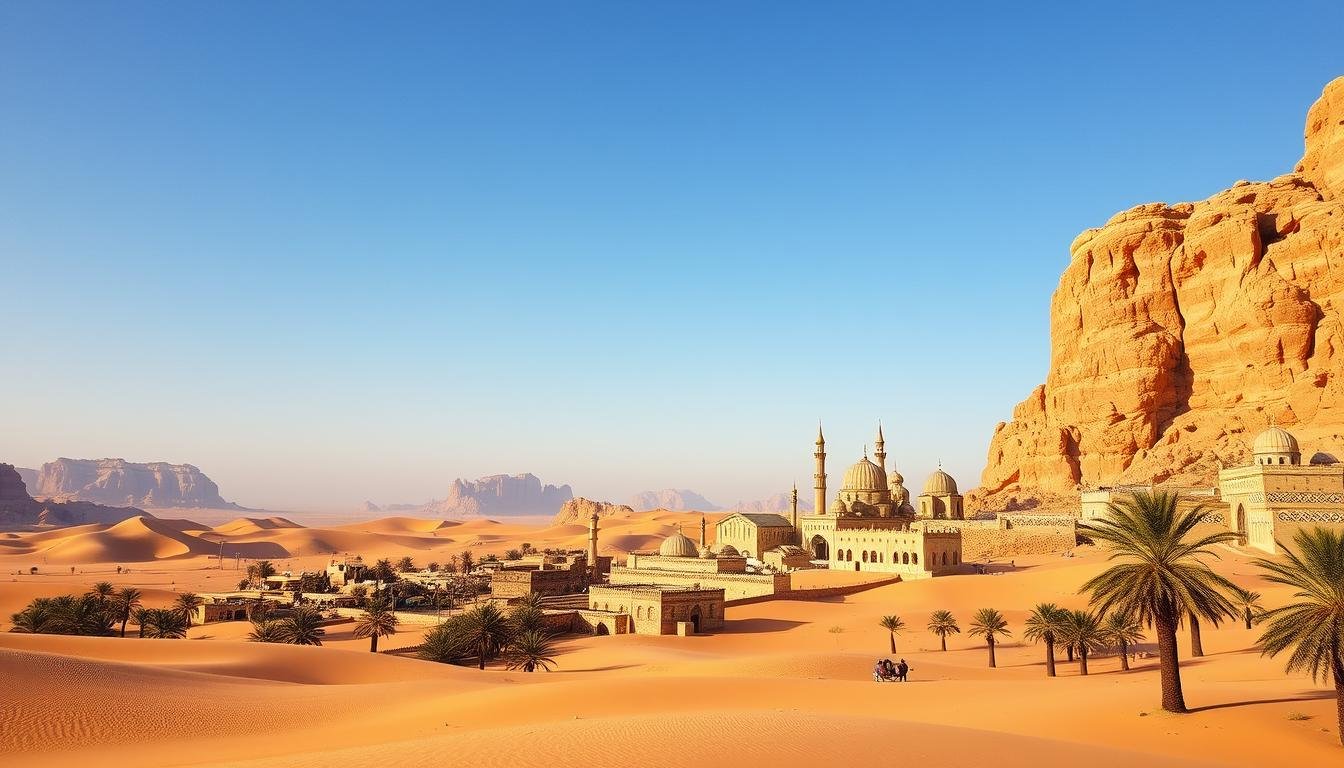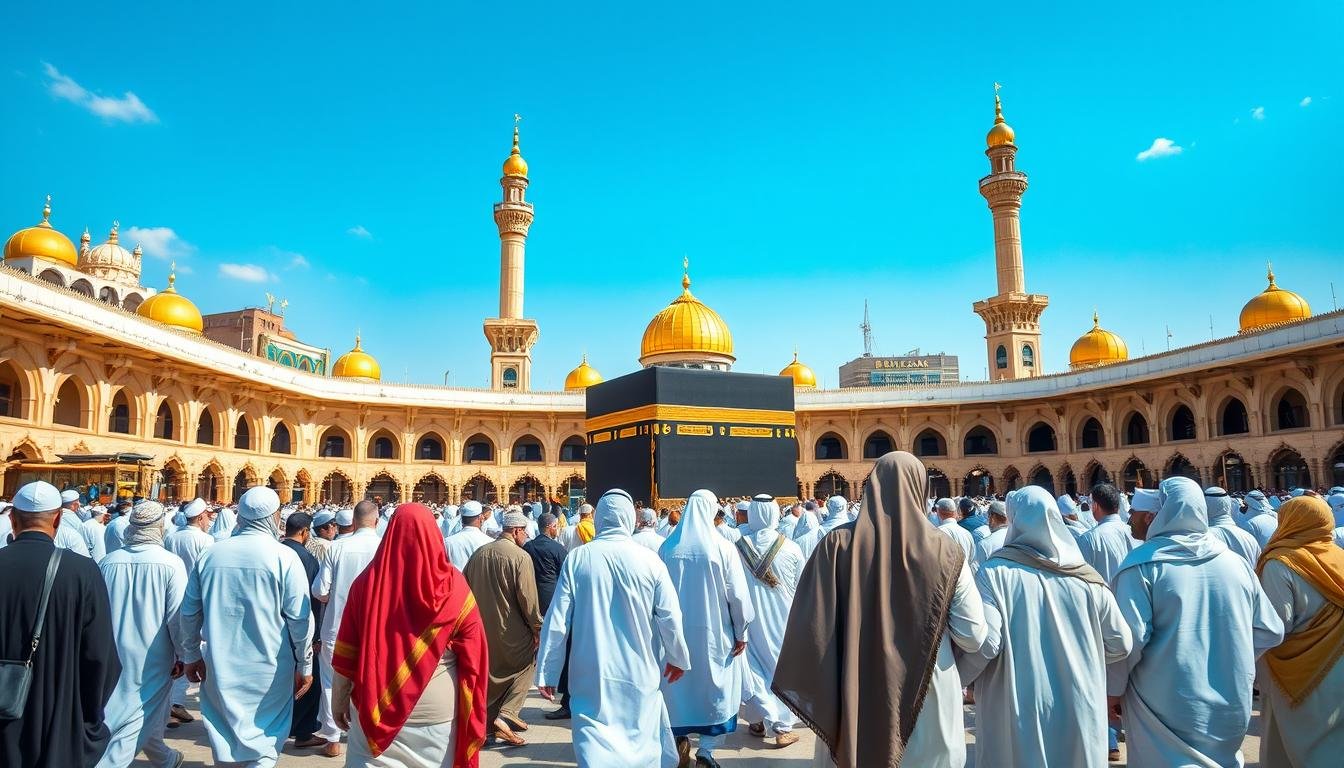Starting the Hajj pilgrimage is a once-in-a-lifetime journey for many Muslims. It’s both exciting and scary for first-timers. You’ll be diving into sacred rituals and visiting Mecca’s holy sites. But what should you really expect on this spiritual trip?
Are you ready to learn about the Hajj and its deep meaning? This guide will help you understand the spiritual journey, key rituals, and practical tips. It will prepare you for your first trip to Mecca.
Preparing for Your Sacred Journey to Mecca
Going on the Hajj pilgrimage is a life-changing journey. But, it needs careful planning. First-time pilgrims must follow key steps for a smooth and spiritually rewarding trip. Let’s look at the main things to do before your sacred trip to Mecca.
Essential Documents and Permissions
Before you can go to Mecca, you need the right documents and permissions. You must get a valid Hajj visa, which can take a lot of time. Also, make sure your passport is current and meets Saudi Arabia’s rules.
Physical and Spiritual Preparation
Hajj is a challenging journey that needs stamina and endurance. You should have a full medical check-up and fix any health issues before going. Spiritually, Hajj is a deep experience. Preparing your heart and mind is just as important. Start by praying regularly, reading the Quran, and doing acts of kindness to feel humble and pious.
Packing Checklist for Hajj
Packing for Hajj needs careful thought. Make sure you have the must-haves, such as:
- Ihram clothing (two white, seamless garments)
- Comfortable walking shoes
- Toiletries and personal hygiene items
- Medicines and any necessary medical supplies
- Prayer mats and personal copies of the Quran
- Modest, comfortable clothing for non-Ihram times
- Sun protection (hats, sunglasses, sunscreen)
- Cash or debit/credit cards for expenses
Don’t pack too much, as you’ll be walking a lot. Focus on the essentials to make your trip easier.
By carefully preparing for your Hajj, you’re ready for a transformative spiritual journey. Stay organized, take care of your health, and keep your heart and mind open to the blessings in the holy land.
Understanding Ihram: Dress Code and Sacred State
Going to Mecca for the Hajj means wearing special clothes called Ihram. These simple garments show the importance of equality and humility. They are key to the Hajj experience.
The Ihram includes two white, seamless pieces. One goes around the waist, and the other over the left shoulder. Wearing Ihram means leaving worldly life behind. It’s about entering a state of spiritual purity.
- Ihram clothing must be free of any decorations, embroidery, or dyed elements.
- Pilgrims are not allowed to cover their heads or wear certain shoes. They also can’t hunt or cut their hair while in Ihram.
- These rules help pilgrims feel humble, devoted, and connected to the divine during the Hajj rituals in Mecca.
Putting on Ihram is a big change. It makes pilgrims leave their everyday lives behind. This is important for the Hajj journey. It connects them with the deep mecca rituals that have lasted for centuries.
What to Expect During Hajj: A Step-by-Step Guide for First-Time Pilgrims
Starting the hajj pilgrimage is both exciting and daunting, especially for newcomers. Knowing the daily schedule, key rituals, and common issues helps make your journey smoother and more meaningful.
Day-by-Day Timeline
The hajj lasts several days, filled with different activities and rituals. Here’s what you can expect:
- Day 1: Arrive in Mecca and perform the Tawaf, circling the Kaaba seven times.
- Day 2: Proceed to Mina, a tent city outside Mecca, and prepare for the journey to Mount Arafat.
- Day 3: Spend the day in prayer and supplication on Mount Arafat, the pinnacle of the hajj.
- Day 4: Move to Muzdalifah, spend the night, and collect pebbles for the Stoning of the Devil ritual.
- Day 5: Perform the Stoning of the Devil in Mina, then return to Mecca for the Tawaf al-Ifadha.
- Day 6-7: Complete optional rites, such as additional Tawaf and Sa’i, and prepare for departure.
Major Rituals Overview
The hajj includes key rituals like the Tawaf, Sa’i, and Stoning of the Devil. It’s important to understand these rites well to fully appreciate your journey.
Common Challenges and Solutions
Dealing with crowds, fatigue, and the Ihram dress code can be tough. But, with good preparation and advice from seasoned pilgrims, you can overcome these hurdles and enjoy the spiritual journey.
Navigating the Tawaf: Circumambulation of the Kaaba
The tawaf, or the ritual circumambulation of the Kaaba, is key to the Hajj pilgrimage in Mecca. For first-time pilgrims, it might seem overwhelming. But with the right mindset and preparation, it can be a life-changing experience.
The Kaaba, a black cubical structure in the Masjid al-Haram mosque, is the heart of the tawaf. Pilgrims must walk around the Kaaba seven times, moving counterclockwise. This act shows unity and devotion to Allah.

To do the tawaf right, pilgrims must be ritually pure and wear the ihram garments. They should stay focused and respectful, reciting prayers and supplications as they go.
- Start the tawaf at the Black Stone, kissing or touching it if you can.
- Keep a steady, moderate pace for the seven circuits.
- Recite specific prayers and dhikr (remembrance of Allah) during the tawaf.
- Avoid physical contact with others and keep a respectful distance.
- Focus on the spiritual meaning of the ritual and your connection to Allah.
Dealing with crowds during the tawaf can be tough. But with patience and kindness, pilgrims can handle it well. Embracing the tawaf as a deep spiritual practice, first-time visitors to Mecca can strengthen their bond with the mecca rituals and the Hajj journey.
Mastering the Sa’i Between Safa and Marwah
The sa’i is a key part of the hajj pilgrimage. It’s a walk between Safa and Marwah hills. This act symbolizes Hagar’s search for water and is deeply meaningful for Muslims.
As a first-time pilgrim, knowing the right way to do it is crucial. You need to understand the proper technique and the prayers involved.
Proper Technique and Prayers
The sa’i involves walking seven times between Safa and Marwah. Start at Safa and end at Marwah. Walk at a steady pace, not too fast or slow.
Recite specific prayers and supplications while walking. These include:
- “Bismillah, Allahu Akbar, Subhana-llah, Alhamdulillah” (In the name of Allah, Allah is the Greatest, Glory be to Allah, All praise is due to Allah)
- “Rabbana atina fid-dunya hasanatan wa fil-akhirati hasanatan” (Our Lord, give us in this world [that which is] good and in the Hereafter [that which is] good)
Physical Requirements and Tips
The sa’i can be tiring, especially for those who don’t walk much. To make it easier and more meaningful, follow these tips:
- Wear comfortable, supportive shoes that have been broken in.
- Drink plenty of water to stay hydrated.
- Take breaks as needed, and don’t feel rushed to complete the ritual.
- Engage in light stretching or exercises before and after the sa’i to prevent muscle soreness.
By mastering the technique, reciting prayers, and preparing your body, you can fully experience the sa’i. This will enrich your hajj pilgrimage.
Life in Mina: What to Know About Tent City
Hajj is a special journey for millions of Muslims. It takes them to Mecca. In Mina, a temporary city, pilgrims live in tents. Knowing what to expect in Mina can make your Hajj better.
Mina is near Mecca and is full of tents for pilgrims. These tents are big and keep everyone cool. They also help people feel like they belong.
Facilities and Amenities in Mina Tent City
- Shared toilet and shower facilities
- Water stations for ablution and drinking
- Prayer areas and mosques within the tent camps
- Medical clinics and first aid stations
- Food and refreshment stalls
- Waste management and cleaning services
Living in Mina needs patience and teamwork. Everyone should be kind and help keep things clean.
Tips for a Comfortable Stay in Mina Tent City
- Pack light and bring only essential items to make navigating the tent city easier.
- Familiarize yourself with the layout of your assigned tent camp and the location of essential facilities.
- Arrive early to secure a spot in your tent and establish a routine for your daily activities.
- Embrace the communal spirit and be courteous to your fellow pilgrims, as you all embark on this sacred journey together.
- Stay hydrated and take breaks to maintain your physical and mental well-being during the hot and demanding days in Mina.
Mina Tent City is a key part of Hajj. It lets pilgrims feel the unity of the journey. By knowing what to expect, first-time pilgrims can enjoy the journey fully.
| Facility | Description |
|---|---|
| Shared Toilets and Showers | The tent city provides communal toilet and shower facilities for all pilgrims. It is important to maintain cleanliness and follow designated times for usage. |
| Water Stations | Water stations are available throughout the tent city for ablution, drinking, and other essential needs. Pilgrims should stay hydrated and use water responsibly. |
| Prayer Areas and Mosques | Each tent camp has designated prayer areas and mosques where pilgrims can perform their daily prayers and religious obligations. |
| Medical Clinics | The tent city is equipped with medical clinics and first aid stations to provide necessary healthcare services to the pilgrims. |
| Food and Refreshment Stalls | Various food and refreshment stalls are available within the tent city, offering sustenance to the pilgrims during their stay. |
| Waste Management | Proper waste management and cleaning services are in place to maintain the cleanliness and orderliness of the tent city. |
The Day of Arafah: Most Important Day of Hajj
The Day of Arafah is on the 9th of Dhul-Hijjah. It’s the peak of the Hajj pilgrimage. Millions of Muslims gather at Arafah to seek forgiveness and connect with God.
Essential Prayers and Supplications
On this day, pilgrims focus on prayers and supplications. They do:
- Recite the Shahada and praise Allah through dhikr.
- Make sincere du’as for forgiveness and blessings.
- Think about their sins and seek forgiveness.
- Read Quran verses about Hajj and Arafah.
Time Management Tips
Managing time well is key on the Day of Arafah. Here’s how:
- Set aside time for important rituals and prayers.
- Use quiet moments for reflection.
- Balance rest and activities to stay energized.
- Work with others to navigate the crowds.
By focusing on the spiritual side and managing time, pilgrims can deeply connect with their faith. They experience the mecca rituals fully.
Muzdalifah and the Stoning of the Devil
The Hajj pilgrimage reaches a climactic moment at Muzdalifah. Here, pilgrims engage in the symbolic act of stoning the devil. This ritual, known as the Ramy al-Jamarat, holds deep spiritual significance. It traces its roots back to the prophet Ibrahim’s (peace be upon him) confrontation with Satan.
Upon arriving at Muzdalifah, pilgrims collect pebbles. These are small stones or pebbles for the Stoning of the Devil ceremony. This is an essential part of the Hajj pilgrimage. It represents the rejection of temptation and a commitment to the righteous path.
- The first Jamarat, or pillar, is stoned with seven pebbles. This signifies the rejection of Satan and his evil whispers.
- Pilgrims then proceed to the second and third Jamarat. They repeat the process of stoning each with seven pebbles.
- This symbolic act is a reminder to continuously resist the temptations of the devil. It reminds us to steadfastly follow the guidance of Allah.
The stoning of the devil ritual requires careful planning and coordination. This ensures the safety of all participants. Designated areas and timetables are established to manage the flow of pilgrims. This minimizes the risk of accidents or injuries.

The Stoning of the Devil ceremony is a profound moment of spiritual cleansing and renewal. As pilgrims engage in this ritual, they reaffirm their commitment to Allah. They reject all that is evil and sinful. It is a powerful testament to the strength of faith and the determination to lead a righteous life.
Completing Your Hajj: Final Rituals and Animal Sacrifice
As you near the end of your journey to Mecca, the final rituals of the Hajj are very important. The ritual animal sacrifice, known as the Udhiyah or Qurbani, is a key act. It remembers the sacrifice of the Prophet Abraham.
This act shows your readiness to give up worldly desires and follow Allah’s will.
Proper Methods of Sacrifice
The animal sacrifice must follow certain rules. You need to pick a halal animal like a sheep, goat, cow, or camel. It must be the right age, without defects, and slaughtered humanely.
Requirements and Alternatives
If you can’t do the sacrifice yourself, someone else can do it for you. Or, you can give money to a group that will do it for you. This is good for those who can’t due to health or money issues.
FAQ
What is the significance of the Hajj pilgrimage?
The Hajj pilgrimage is a sacred journey every Muslim must take once in their life. It’s a deep spiritual experience that connects me to the Prophet Muhammad and Islam’s history. The Hajj lets me purify my soul, seek forgiveness, and renew my faith commitment.
What are the essential documents and permissions I need to obtain for Hajj?
For Hajj, you need a valid passport, a Hajj visa, and a health certificate. You must also register with a certified Hajj travel agency and get the necessary permits and vaccinations. Start the application process early to ensure you have all the required documents.
How should I prepare physically and spiritually for the Hajj pilgrimage?
To prepare physically for Hajj, make sure you’re in good health and have enough stamina. Carry necessary medications and supplies. Spiritually, focus on purifying your intentions, seeking forgiveness, and strengthening your connection with Allah through prayer and reflection. Settle debts, mend relationships, and make amends before the journey.
What is the significance of Ihram, the sacred attire worn during Hajj?
Ihram is the white, seamless garment all Hajj pilgrims wear. It symbolizes equality and humility before Allah. Wearing Ihram means you must avoid certain activities, like covering your head or engaging in sexual relations. It helps you focus spiritually during the Hajj.
Can you provide a step-by-step timeline of the Hajj pilgrimage?
The Hajj pilgrimage lasts about 5-6 days. It includes key events like arriving in Mecca, performing the Tawaf, and traveling to Mina. You’ll spend time at Mount Arafat, return to Muzdalifah, and perform the Stoning of the Devil. Finally, you’ll complete the Tawaf al-Ifadha and depart Mecca.
What is the proper technique for performing the Tawaf around the Kaaba?
The Tawaf is a central Hajj ritual. Walk around the Kaaba in a counter-clockwise direction, keeping it on your left. Recite specific prayers and focus on the spiritual significance. Stay calm and reverent, mindful of the crowds.
What is the significance of the Sa’i between Safa and Marwah?
The Sa’i commemorates Hagar’s search for water. It represents my own spiritual quest. Walk briskly between Safa and Marwah, pausing to pray and reflect on its significance.
What should I expect from staying in the Mina tent city?
Mina is a temporary encampment near Mecca. The accommodations are basic, with large communal tents. Living conditions are simple, but the shared spiritual connection with fellow pilgrims is profound. Be prepared for crowds, finding your tent, and adapting to shared facilities.
What is the significance of the Day of Arafah, and how should I make the most of it?
The Day of Arafah is the Hajj’s most important day. Spend time in reflection, prayer, and supplication. Seek forgiveness and renew your commitment to Allah. Make the most of this day by managing your time, participating in communal prayers, and focusing on spiritual introspection.
How do I properly perform the ritual of stoning the devil at Jamarat?
The Stoning of the Devil represents rejecting Satan’s temptations. Travel to Jamarat, throw seven stones at the devil’s pillars, and follow the proper technique. Safety is crucial, so be mindful of your surroundings and follow authorities’ instructions.
What are the final rituals and the animal sacrifice required to complete the Hajj?
The final stage includes the ritual animal sacrifice, Udhiyah or Qurbani. It symbolizes the Prophet Abraham’s sacrifice. Ensure you follow the proper methods of sacrifice or arrange for it to be done on your behalf. Completing these rituals marks the end of your Hajj journey.
Don’t forget to share your experience in the comments and follow us on social media at the bottom of the site.
